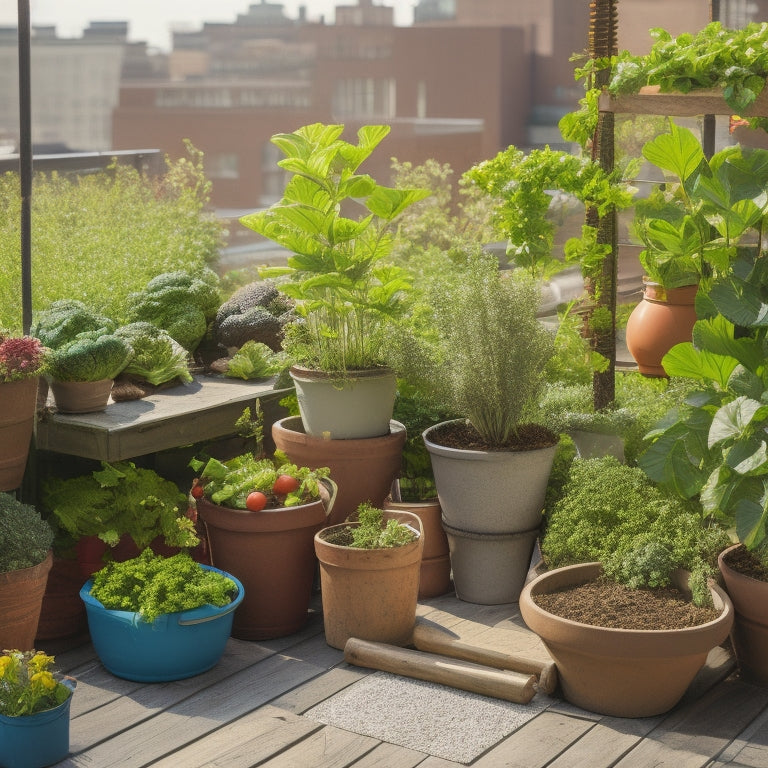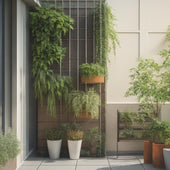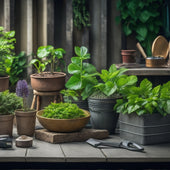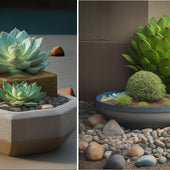
Fertilizing Small Vegetable Gardens on a Rooftop
Share
When fertilizing your small vegetable garden on a rooftop, choose a fertilizer specifically formulated for container-based growing. Opt for natural, organic options that enrich soil with compost and manure, promoting healthy microbial activity and soil structure. Select a well-draining potting mix and implement a rooftop garden irrigation system for water conservation. Test soil pH levels regularly and adjust fertilizer application accordingly. Balance nutrient levels, considering ideal ratios for nitrogen, phosphorus, and potassium. By making informed choices, you'll be on your way to a thriving, sustainable rooftop garden - and there's even more to learn about maximizing your harvest.
Choosing the Right Fertilizer
When it comes to fertilizing your rooftop vegetable garden, you need to select a fertilizer that's specifically formulated for small-scale, container-based growing. This type of fertilizer is designed to provide the right balance of nutrients for your vegetables to thrive in a limited space.
You'll find three main types of fertilizers: water-soluble, granular, and slow-release. Water-soluble fertilizers are great for frequent feeding, while granular ones provide a slow release of nutrients. Slow-release fertilizers offer a steady supply of nutrients over an extended period.
Your vegetable garden needs a balanced diet of nitrogen (N), phosphorus (P), and potassium (K) to grow strong and healthy. Look for a fertilizer with a balanced N-P-K ratio, such as 10-10-10 or 20-20-20. You may also consider fertilizers with added micronutrients like iron, calcium, and magnesium.
When applying fertilizer, be sure to follow the instructions on the label and avoid over-fertilizing, which can harm your plants. By choosing the right fertilizer and applying it correctly, you'll be on your way to a thriving rooftop vegetable garden.
Organic Vs Synthetic Options
When it comes to fertilizing your rooftop veggie garden, you're faced with an important decision: organic or synthetic?
You'll want to think about the benefits of natural fertilizers, like promoting healthy soil and reducing environmental harm.
Natural Fertilizer Benefits
By opting for natural fertilizers, you'll reap a multitude of benefits that synthetic options simply can't match, and we're about to explore the advantages that make organic fertilizers the go-to choice for rooftop vegetable gardens.
Soil enrichment is a top priority when it comes to natural fertilizers. Organic matter like compost, manure, and worm castings enrich the soil, promoting healthy microbial activity and structure. This, in turn, supports sustainability by reducing the need for chemical additives and preserving soil health for future generations.
Natural fertilizers also foster plant growth by providing essential nutrients, improving water retention, and encouraging strong root development. This leads to more resilient, disease-resistant plants that thrive in harmony with their environment.
Synthetic Fertilizer Drawbacks
You'll likely face a host of problems if you opt for synthetic fertilizers, which can contaminate soil, air, and water with toxic chemicals that harm the environment and human health. These chemicals can seep into groundwater, polluting it and threatening the health of people and wildlife. Additionally, they can also contribute to air pollution, further exacerbating respiratory issues like asthma.
In addition to the environmental impact, synthetic fertilizers also raise health concerns. They've been linked to an increased risk of cancer, birth defects, and other health problems. Moreover, synthetic fertilizers are often formulated to provide quick fixes, but they don't promote soil health or long-term sustainability. This means you'll need to keep applying them, which can be costly and unsustainable in the long run.
In contrast, natural fertilizers offer a more cost-effective and sustainable solution, promoting healthy soil and a thriving ecosystem. By choosing natural fertilizers, you'll not only avoid the drawbacks of synthetic ones but also create a more resilient and sustainable rooftop garden.
Eco-Friendly Choices Matter
Now that you're aware of the drawbacks of synthetic fertilizers, it's time to explore the eco-friendly alternatives that can help you create a thriving rooftop garden.
As an urban agriculture enthusiast, you're likely committed to sustainable practices that benefit both your garden and the environment. Organic fertilizers are a great place to start. These natural options promote healthy soil biota, improve soil structure, and increase water retention. Plus, they're free from harsh chemicals that can harm local wildlife and contaminate waterways.
When selecting organic fertilizers, look for products made from natural ingredients like compost, manure, or fish bone meal. You can also create your own fertilizers using kitchen scraps, leaf mold, or worm composting. These DIY approaches not only reduce waste but also provide a sense of accomplishment and connection to your garden.
Rooftop Garden Soil Considerations
When creating a rooftop garden, selecting the right soil mix is crucial, as it must be capable of draining excess water quickly and supporting plant growth in shallow containers. You'll want to choose a well-draining potting mix that's specifically tailored for rooftop gardens. Look for mixes that contain ingredients like perlite, vermiculite, or sand to enhance drainage. This will help prevent waterlogged soil and root rot.
When it comes to rooftop container options, choose ones with built-in drainage solutions, such as holes or mesh layers, to make certain excess water can escape. This will also aid in water conservation, as you won't need to water as frequently.
Additionally, consider implementing a rooftop garden irrigation system that delivers water directly to the roots, reducing evaporation and runoff. By selecting the appropriate soil mix and containers, you'll be well on your way to creating a flourishing rooftop garden that's both sustainable and productive.
Balancing Nutrient Levels
When you're fertilizing your rooftop vegetable garden, getting the nutrient balance right is important. You'll need to take into account your soil's pH levels, as they can affect how well your plants absorb nutrients.
Soil Ph Levels Matter
You'll want to test your rooftop soil's pH levels regularly, as even minor imbalances can greatly impact the availability of essential nutrients for your vegetables. pH testing is an important step in ensuring your soil provides the necessary nutrients for healthy plant growth.
When your soil's pH levels are off, it can affect nutrient absorption, leading to deficiencies and poor vegetable quality. For instance, if your soil is too alkaline, it can limit the availability of essential micronutrients like iron and zinc. On the other hand, if your soil is too acidic, it can be challenging to grow vegetables that prefer a more neutral pH, like tomatoes and cucumbers.
Acidic vegetables like strawberries and blueberries, however, thrive in slightly acidic soil. To achieve best pH levels, you'll need to adjust your fertilizer application accordingly. By monitoring your soil's pH levels and making adjustments as needed, you'll be able to provide your vegetables with the necessary nutrients for ideal growth and production.
Nutrient Deficiency Signs
Take a closer look at your plants, and you'll likely spot signs of nutrient deficiency, such as yellowing leaves, stunted growth, or weak stems, which can serve as a wake-up call to rebalance your soil's nutrient levels.
These signs don't have to be a permanent setback, but rather an opportunity to identify and correct the issue. Plant discoloration, for instance, can be a clear indication of nutrient deficiency. If your leaves are turning yellow or pale, it may be a sign that your plants are lacking essential nutrients like nitrogen or iron.
Stunted growth is another common sign of nutrient deficiency, which can be caused by a lack of phosphorus or potassium.
Optimal Fertilizer Ratios
Now that you've identified potential nutrient deficiencies, it's time to rebalance your soil's nutrient levels by applying the appropriate fertilizer ratios. A balanced fertilizer application is essential for best nutrient absorption. Aim for a ratio that provides equal amounts of nitrogen (N), phosphorus (P), and potassium (K). This is often represented as N-P-K, such as 10-10-10.
| Nutrient | Ideal Ratio |
|---|---|
| Nitrogen (N) | 10-15% |
| Phosphorus (P) | 10-15% |
| Potassium (K) | 5-10% |
When choosing a fertilizer, consider the specific needs of your vegetables. For example, leafy greens require more nitrogen, while fruiting vegetables like tomatoes need more phosphorus. Be cautious not to overfertilize, as this can harm your plants and the environment. Start with a balanced ratio and adjust as needed based on your plants' response. By applying the appropriate fertilizer ratios, you'll promote healthy growth, increase yields, and enjoy a thriving rooftop garden.
Fertilizer Application Methods
When fertilizing your rooftop vegetable garden, mix granular or powdered fertilizers into the soil according to the product's guidelines. This guarantees even fertilizer distribution, allowing your plants to absorb the required nutrients efficiently.
For best nutrient absorption, you can also side-dress your plants with a water-soluble fertilizer. This method provides an instant boost of nutrients, promoting healthy growth and development.
When it comes to application frequency, you'll need to adjust it according to the season. During peak growth seasons, you may need to fertilize more frequently, every 1-2 weeks. However, during slower growth periods, you can reduce the application frequency to once a month.
Seasonal adjustments are essential to avoid over-fertilizing, which can harm your plants and the environment. By following these fertilizer application methods, you'll be able to provide your rooftop vegetable garden with the necessary nutrients to thrive.
Remember to always follow the product's guidelines and take into account your plants' specific needs to achieve a bountiful harvest.
Timing Fertilizer Applications
You'll want to time your fertilizer applications strategically to coincide with your plants' growth stages, maximizing their impact and promoting ideal development. This means applying fertilizers during seasonal shifts when your plants need an extra boost.
For example, during the spring, when seedlings are emerging, a balanced fertilizer will provide essential nutrients for healthy growth. As your plants mature, you can switch to a fertilizer rich in phosphorus to promote fruiting and flowering.
Proper fertilizer distribution is key to achieving growth sustainability. Divide your rooftop garden into sections, and apply fertilizers accordingly. This guarantees each plant receives the necessary nutrients without over-fertilizing, which can harm the environment and your plants.
Aim to maintain a nutrient-rich soil by applying fertilizers at the right time and in the right amounts. By doing so, you'll create a thriving ecosystem that supports the growth of your vegetables, while also reducing waste and environmental impact.
Maintaining Soil Health Long-Term
To maintain a thriving rooftop garden, prioritizing soil health in the long run is essential, as it serves as the foundation of a sustainable and productive growing space.
You'll want to adopt sustainable practices that promote soil health, such as composting. Composting benefits your soil by increasing its water-holding capacity, structure, and fertility, while also supporting nutrient cycling. This process breaks down organic matter into nutrients that your vegetables can absorb, reducing the need for synthetic fertilizers.
In addition to composting, consider using natural soil amendments like manure, green sand, or alfalfa meal to enrich your soil. These amendments will help maintain a balanced pH, improve soil structure, and provide essential micronutrients.
By incorporating these practices into your rooftop garden routine, you'll be supporting a diverse and thriving ecosystem. Remember, a healthy soil ecosystem is key to growing robust and resilient vegetables.
Frequently Asked Questions
Can I Use Fertilizer From My Indoor Plants on My Rooftop Garden?
You think your indoor plant fertilizer is the perfect solution for your rooftop garden, but surprisingly, it's not compatible. Prevent fertilizer runoff by choosing a rooftop-specific fertilizer, and enjoy your thriving, liberated garden!
How Do I Protect My Rooftop Garden From Fertilizer Runoff?
To prevent fertilizer runoff, you'll want to implement measures like rainwater collection systems and vegetative barriers around your rooftop garden, ensuring excess nutrients don't harm the environment and surrounding ecosystems.
Are There Any Fertilizer Options Specifically for Rooftop Gardens?
You're likely aware that 70% of urban gardens face soil degradation; now, when it comes to fertilizing, you'll find organic options and specialty blends designed for rooftop gardens, providing a safe and effective way to nourish your crops.
Can I Make My Own Fertilizer for My Rooftop Vegetable Garden?
You can create your own fertilizer using homemade compost, which provides organic nutrients. Try DIY fertilizer recipes like banana peels, eggshells, or coffee grounds for natural options that'll give your plants a boost.
Will Fertilizer Affect the Taste of My Rooftop-Grown Vegetables?
You're wondering if fertilizer will affect the taste of your veggies. The answer depends on the fertilizer type and soil composition. Organic fertilizers have minimal flavor impact, while synthetic ones can alter nutrient absorption, affecting taste.
Related Posts
-

3 Best Space-Saving Gardening Ideas for Urban Renters
You can turn even the smallest urban space into a lush oasis by utilizing clever space-saving gardening ideas. Maximi...
-

3 Best Space-Saving Gardening Ideas for Urban Renters
You can turn even the smallest urban space into a lush oasis by utilizing clever space-saving gardening ideas. Maximi...
-

3 Best Space-Saving Gardening Ideas for Urban Renters
You can turn even the smallest urban space into a lush oasis by utilizing clever space-saving gardening ideas. Maximi...
-

3 Best Space-Saving Gardening Ideas for Urban Renters
You can turn even the smallest urban space into a lush oasis by utilizing clever space-saving gardening ideas. Maximi...
-

3 Best Space-Saving Gardening Ideas for Urban Renters
You can turn even the smallest urban space into a lush oasis by utilizing clever space-saving gardening ideas. Maximi...
-

3 Best Space-Saving Gardening Ideas for Urban Renters
You can turn even the smallest urban space into a lush oasis by utilizing clever space-saving gardening ideas. Maximi...
-

3 Best Space-Saving Gardening Ideas for Urban Renters
You can turn even the smallest urban space into a lush oasis by utilizing clever space-saving gardening ideas. Maximi...
-

3 Best Space-Saving Gardening Ideas for Urban Renters
You can turn even the smallest urban space into a lush oasis by utilizing clever space-saving gardening ideas. Maximi...
-

3 Best Space-Saving Gardening Ideas for Urban Renters
You can turn even the smallest urban space into a lush oasis by utilizing clever space-saving gardening ideas. Maximi...
-

3 Best Space-Saving Gardening Ideas for Urban Renters
You can turn even the smallest urban space into a lush oasis by utilizing clever space-saving gardening ideas. Maximi...
-

3 Best Space-Saving Gardening Ideas for Urban Renters
You can turn even the smallest urban space into a lush oasis by utilizing clever space-saving gardening ideas. Maximi...
-

3 Best Space-Saving Gardening Ideas for Urban Renters
You can turn even the smallest urban space into a lush oasis by utilizing clever space-saving gardening ideas. Maximi...
-

3 Best Space-Saving Gardening Ideas for Urban Renters
You can turn even the smallest urban space into a lush oasis by utilizing clever space-saving gardening ideas. Maximi...
-

3 Best Space-Saving Gardening Ideas for Urban Renters
You can turn even the smallest urban space into a lush oasis by utilizing clever space-saving gardening ideas. Maximi...
-

Why Do Cinder Block Planter Tools Cost So Much
You'll likely spend at least $200 to $500 on essential tools for a DIY cinder block planter project, with high-end op...
-

Why Do Cinder Block Planter Tools Cost So Much
You'll likely spend at least $200 to $500 on essential tools for a DIY cinder block planter project, with high-end op...
-

Why Do Cinder Block Planter Tools Cost So Much
You'll likely spend at least $200 to $500 on essential tools for a DIY cinder block planter project, with high-end op...
-

Why Do Cinder Block Planter Tools Cost So Much
You'll likely spend at least $200 to $500 on essential tools for a DIY cinder block planter project, with high-end op...
-

Why Do Cinder Block Planter Tools Cost So Much
You'll likely spend at least $200 to $500 on essential tools for a DIY cinder block planter project, with high-end op...
-

Why Do Cinder Block Planter Tools Cost So Much
You'll likely spend at least $200 to $500 on essential tools for a DIY cinder block planter project, with high-end op...
-

Why Do Cinder Block Planter Tools Cost So Much
You'll likely spend at least $200 to $500 on essential tools for a DIY cinder block planter project, with high-end op...
-

Why Do Cinder Block Planter Tools Cost So Much
You'll likely spend at least $200 to $500 on essential tools for a DIY cinder block planter project, with high-end op...
-

Why Do Cinder Block Planter Tools Cost So Much
You'll likely spend at least $200 to $500 on essential tools for a DIY cinder block planter project, with high-end op...
-

Why Do Cinder Block Planter Tools Cost So Much
You'll likely spend at least $200 to $500 on essential tools for a DIY cinder block planter project, with high-end op...
-

Why Do Cinder Block Planter Tools Cost So Much
You'll likely spend at least $200 to $500 on essential tools for a DIY cinder block planter project, with high-end op...
-

Why Do Cinder Block Planter Tools Cost So Much
You'll likely spend at least $200 to $500 on essential tools for a DIY cinder block planter project, with high-end op...
-

Why Do Cinder Block Planter Tools Cost So Much
You'll likely spend at least $200 to $500 on essential tools for a DIY cinder block planter project, with high-end op...
-

Why Do Cinder Block Planter Tools Cost So Much
You'll likely spend at least $200 to $500 on essential tools for a DIY cinder block planter project, with high-end op...
-

Why Do Cinder Block Planter Tools Cost So Much
You'll likely spend at least $200 to $500 on essential tools for a DIY cinder block planter project, with high-end op...
-

Why Do Cinder Block Planter Tools Cost So Much
You'll likely spend at least $200 to $500 on essential tools for a DIY cinder block planter project, with high-end op...
-

Why Do Cinder Block Planter Tools Cost So Much
You'll likely spend at least $200 to $500 on essential tools for a DIY cinder block planter project, with high-end op...
-

Why Do Cinder Block Planter Tools Cost So Much
You'll likely spend at least $200 to $500 on essential tools for a DIY cinder block planter project, with high-end op...
-

Why Do Cinder Block Planter Tools Cost So Much
You'll likely spend at least $200 to $500 on essential tools for a DIY cinder block planter project, with high-end op...
-

Why Do Cinder Block Planter Tools Cost So Much
You'll likely spend at least $200 to $500 on essential tools for a DIY cinder block planter project, with high-end op...
-

Why Do Cinder Block Planter Tools Cost So Much
You'll likely spend at least $200 to $500 on essential tools for a DIY cinder block planter project, with high-end op...
-

Why Do Cinder Block Planter Tools Cost So Much
You'll likely spend at least $200 to $500 on essential tools for a DIY cinder block planter project, with high-end op...
-

Why Do Cinder Block Planter Tools Cost So Much
You'll likely spend at least $200 to $500 on essential tools for a DIY cinder block planter project, with high-end op...
-

Why Do Cinder Block Planter Tools Cost So Much
You'll likely spend at least $200 to $500 on essential tools for a DIY cinder block planter project, with high-end op...
-

Why Do Cinder Block Planter Tools Cost So Much
You'll likely spend at least $200 to $500 on essential tools for a DIY cinder block planter project, with high-end op...
-

Why Do Cinder Block Planter Tools Cost So Much
You'll likely spend at least $200 to $500 on essential tools for a DIY cinder block planter project, with high-end op...
-

Why Do Cinder Block Planter Tools Cost So Much
You'll likely spend at least $200 to $500 on essential tools for a DIY cinder block planter project, with high-end op...
-

Why Do Cinder Block Planter Tools Cost So Much
You'll likely spend at least $200 to $500 on essential tools for a DIY cinder block planter project, with high-end op...
-

Why Do Cinder Block Planter Tools Cost So Much
You'll likely spend at least $200 to $500 on essential tools for a DIY cinder block planter project, with high-end op...
-

Why Do Cinder Block Planter Tools Cost So Much
You'll likely spend at least $200 to $500 on essential tools for a DIY cinder block planter project, with high-end op...
-

Why Do Cinder Block Planter Tools Cost So Much
You'll likely spend at least $200 to $500 on essential tools for a DIY cinder block planter project, with high-end op...
-

Succulent-Friendly Drainage Solutions for Block Planters
You can create a succulent-friendly drainage system in your cinder block planters by drilling holes in the bottom of ...
-

Succulent-Friendly Drainage Solutions for Block Planters
You can create a succulent-friendly drainage system in your cinder block planters by drilling holes in the bottom of ...
-

Succulent-Friendly Drainage Solutions for Block Planters
You can create a succulent-friendly drainage system in your cinder block planters by drilling holes in the bottom of ...
-

Succulent-Friendly Drainage Solutions for Block Planters
You can create a succulent-friendly drainage system in your cinder block planters by drilling holes in the bottom of ...
-

Succulent-Friendly Drainage Solutions for Block Planters
You can create a succulent-friendly drainage system in your cinder block planters by drilling holes in the bottom of ...
-

Succulent-Friendly Drainage Solutions for Block Planters
You can create a succulent-friendly drainage system in your cinder block planters by drilling holes in the bottom of ...
-

Succulent-Friendly Drainage Solutions for Block Planters
You can create a succulent-friendly drainage system in your cinder block planters by drilling holes in the bottom of ...
-

Succulent-Friendly Drainage Solutions for Block Planters
You can create a succulent-friendly drainage system in your cinder block planters by drilling holes in the bottom of ...
-

Succulent-Friendly Drainage Solutions for Block Planters
You can create a succulent-friendly drainage system in your cinder block planters by drilling holes in the bottom of ...
-

Succulent-Friendly Drainage Solutions for Block Planters
You can create a succulent-friendly drainage system in your cinder block planters by drilling holes in the bottom of ...
-

Succulent-Friendly Drainage Solutions for Block Planters
You can create a succulent-friendly drainage system in your cinder block planters by drilling holes in the bottom of ...
-

Succulent-Friendly Drainage Solutions for Block Planters
You can create a succulent-friendly drainage system in your cinder block planters by drilling holes in the bottom of ...
-

Succulent-Friendly Drainage Solutions for Block Planters
You can create a succulent-friendly drainage system in your cinder block planters by drilling holes in the bottom of ...
-

Succulent-Friendly Drainage Solutions for Block Planters
You can create a succulent-friendly drainage system in your cinder block planters by drilling holes in the bottom of ...
-

Succulent-Friendly Drainage Solutions for Block Planters
You can create a succulent-friendly drainage system in your cinder block planters by drilling holes in the bottom of ...


